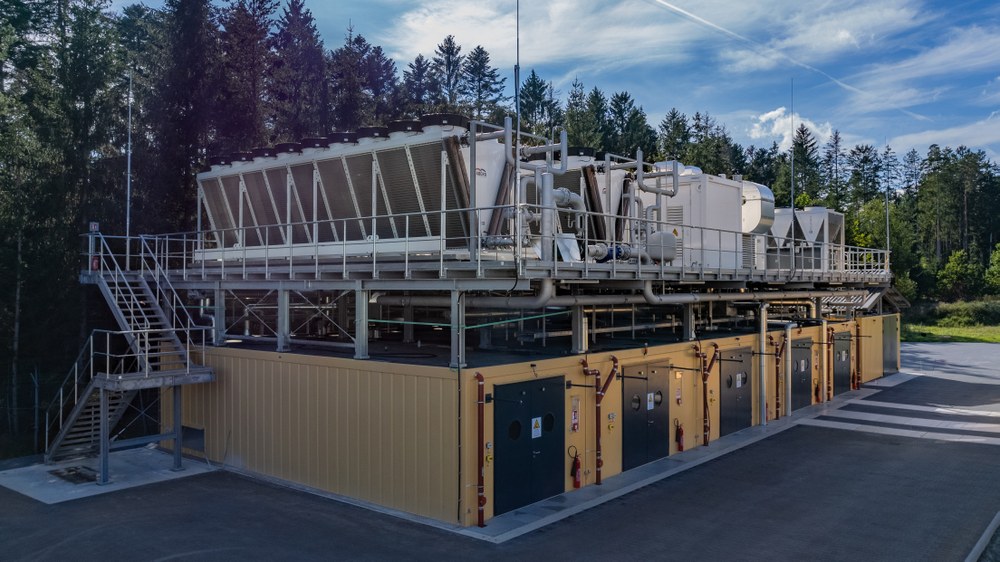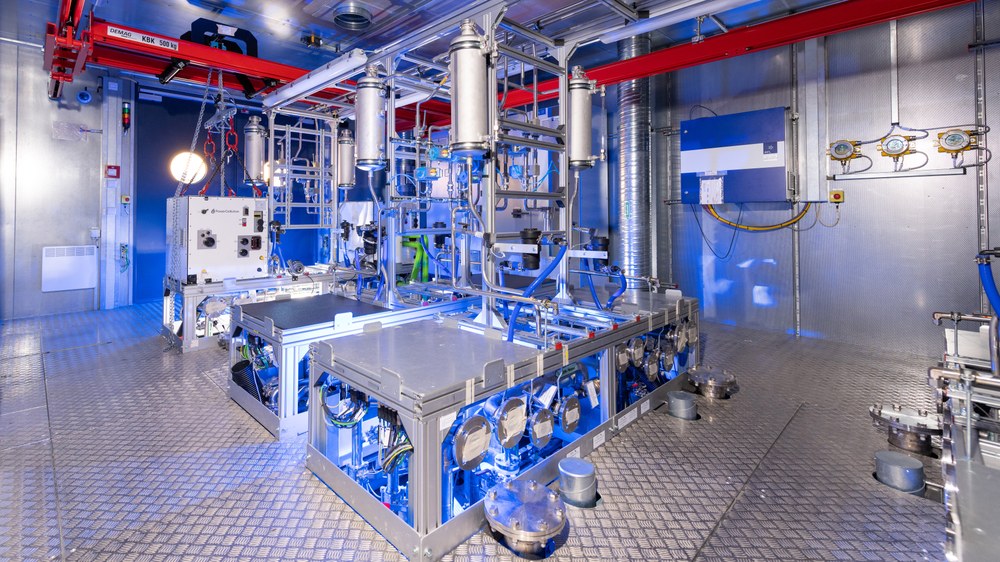Official opening of the DLR BALIS test centre



- DLR officially opened the BALIS test facility in Empfingen on 28 October 2024.
- With this unique test infrastructure, DLR is able to develop and test innovative propulsion systems based on hydrogen fuel cells, achieving outputs in the megawatt range.
- Such propulsion systems are not yet commercially available.
- In the future, these systems could enable CO2-free mobility in applications such as ship propulsion and, in the long term, aviation.
- Focus: Energy, transport, aeronautics, hydrogen technologies, future mobility, climate-compatible flying
As part of the BALIS project, the German Aerospace Center (Deutsches Zentrum für Luft- und Raumfahrt; DLR) is setting up a unique scientific test facility in Empfingen. DLR is using the facility to develop and test fuel cell propulsion systems for various modes of transport. The BALIS project is focusing on fuel cell assemblies with an output of around 1.5 megawatts, which while not yet available on the market, could be used to power ships or, eventually, aviation. Using hydrogen from renewable sources, known as green hydrogen, in fuel cells enables carbon-dioxide-free mobility, making it compatible with climate and environmental goals. The plant is located on the Innovation Campus of the E2U Empfinger Entwicklungszentrum für Umwelttechnologie ('Development Centre for Environmental Technology'). The official opening ceremony took place at the site on 28 October 2024 with representatives from politics, public administration and industry. The Federal Ministry for Digital and Transport is providing funding of 26 million euros for the BALIS test centre.
Unique test facility for fuel cell powertrains for transport applications
"The dialogue between research and industry that arises from the construction and use of large-scale facilities like BALIS is invaluable for both sides. This is how we not only jointly demonstrate that new technologies are functional, but also develop them to a size and economic viability that make them an interesting solution for industry," said Karsten Lemmer, DLR Executive Board Member for Innovation, Transfer and Research Infrastructure. "In aviation in particular, the step up from a stable propulsion system on the ground to qualification for use in aircraft is very complex and takes time. A facility like BALIS provides the basis and reliability needed to transform aviation."
"The opening of the test facility is a decisive step towards achieving climate neutrality by 2045. Transport faces major challenges, and hydrogen offers us the opportunity to develop and implement emission-free propulsion systems for various means of transport. We are providing targeted funding to support research and development for the creation of innovative and ultimately marketable solutions. Together with industry and research, we are laying the foundations for sustainable mobility," explained Hartmut Höppner, State Secretary at the Federal Ministry for Digital and Transport.
"Hydrogen technologies are central to energy and transport research at DLR. Unlike other research centres, DLR covers the entire process chain with its interdisciplinary expertise in aeronautics, space, energy, transport, security and digitalisation, from materials and processes for producing renewable hydrogen, to applications in mobile and stationary systems, to system analysis. It shows the contexts and conditions under which hydrogen technologies can create an economically viable, safe and sustainable energy and mobility system," added Meike Jipp, DLR Divisional Board Member for Energy and Transport.
The complex and modular BALIS test facility, housed entirely in shipping containers, enables individual components and entire powertrains to be comprehensively investigated. This includes the fuel cell system itself, electric motors, refuelling infrastructure and control and regulation technology. The facility is unique worldwide due to its flexible design and the associated research methodology. The DLR Institute for Engineering Thermodynamics is responsible for the project.
New generation of fuel cell systems for climate-compatible mobility
In addition to setting up and operating the test facility, DLR is also building its own pioneering megawatt-class electric propulsion system. It consists of a fuel cell assembly, hydrogen tank, electric motor, control components and power electronics and can be used to thoroughly record, understand and qualify all the process steps of a fuel cell propulsion system. The largest commercially available fuel cells for mobile applications have an output of up to several hundred kilowatts. To reach the megawatt range, fuel cell systems need to be constructed from several interconnected modules. This results in high operating voltages and currents that must be optimally controlled for stable and efficient operation. At the same time, low weight and high efficiency in the drive system are crucial for commercial application in the heavy-duty sector. The initial focus of the work is therefore on the behaviour and optimisation of this megawatt drive system for stable operation under various load regimes.
A further research focus: handling and using liquid hydrogen
Another research focus of the BALIS test facility is the handling of liquid hydrogen (LH2) in large quantities for the operation of the entire propulsion system. To this end, DLR is constructing a test tank and refuelling infrastructure with additional funds of approximately three million euros. In terms of storage, liquid hydrogen has a higher density than gaseous hydrogen and so takes up much less space, but hydrogen only becomes liquid at very low temperatures, starting at minus 253 degrees Celsius (hence the term ‘cryogenic hydrogen’). For this reason, liquefying, storing and transporting hydrogen place particular demands on infrastructure to keep the pressure and temperature constant.
Close cooperation with industry: fully booked for the next few years
The BALIS test centre is already at full capacity for the next three years with research and cooperation projects involving industrial enterprises. DLR is working with a range of companies, including innovative start-ups, established medium-sized companies and global players in the energy and aviation sectors. Among them are the DLR spin-off H2FLY, the fuel cell manufacturer PowerCell, the electric drive specialist Compact Dynamics and the manufacturer and supplier of technical gases Air Liquide. In the aviation sector, DLR collaborates with companies such as Diehl Aviation, GE Aerospace and Deutsche Aircraft. AVL worked with DLR on the design and construction of the facility.
Related links
BALIS project funding and coordination
The BALIS project was funded as part of the National Innovation Programme for Hydrogen and Fuel Cell Technology (NIP) with a total of almost 30 million euros from the Federal Ministry for Digital and Transport (BMDV) and financed by the Energy and Climate Fund. The funding guideline was coordinated by the National Organisation for Hydrogen and Fuel Cell Technology (NOW) and implemented by Project Management Jülich (PtJ).
